This seed manager dives into cover crop varieties and how they relate to soil health.
Cover crops have become one of the ag industry’s most exciting and valuable trends in recent years, and for good reason: Covers have been shown to build healthy sustainable soil and contribute to higher crop productivity. But part of maximizing your success means finding the right cover crops for your land, and that’s not always an easy thing to do. For that reason, my guide to cover crops hopes to pinpoint some of the things you should look for in a cover crop, as well as the strengths and drawbacks of some key varieties.
It’s been nice to return to a mostly normal planting season. There’s no question that some recent years, with its tricky weather and delayed planting, it was difficult to watch as American farmers struggle to get their cash crops in the ground and have the option to use cover crops to complement their farming operation.
Just a couple of years ago, we saw a huge spike in a diverse cover crop species selection with the large number of acres in North America that qualified for prevent plant. Many farmers facilitated the growth of plant species that had never been purposely raised on their farm. From my point of view, we learned a lot from the past couple of seasons. We pushed new limits in comfort and familiarity with cover crop species due to the industry’s supply from early season demand for prevent plant acres.
Regardless of the situation, though, as a professional cover crop manager, I’m one of the most popular people to farmers, ag retailers, seed salesmen, and farming enthusiasts this time of year. I enjoy any opportunity to be the cool kid (because this never happens), and I am happy to help and am grateful for the opportunity to share my knowledge through this detailed guide to cover crops and how they relate to soil health. Please note, the perspectives and opinions that follow are my own.
Read more from Cover Crop Gal blogger Jenna Blue here.
This is my daily dialogue with farmers, seed salesmen, and anyone who’s willing to listen:
Tillage Radish (daikon type) — The Poster Child For Cover Crops
I caught myself recently defending Tillage Radish with the statement, “You’re un-American if you don’t like radishes.” Nothing stops you dead in your tracks in your 30s like the moment you realize you’re defending a giant brassica that rots in the late winter and smells like death. The unbiased truth of the radish is that it’s an excellent cover crop for beginners and veterans. It has rapid growth and will help suppress weeds. A healthy, well-fed radish will grow a strong taproot that can reach to depths of 6 feet or more. Radishes cycle and sequester nutrients below ground while working to provide wind and water erosion control above ground. Under the soil surface, it’s busting up compaction with its taproot, lateral roots, and root hairs. These same roots can be storing large amounts of nutrients that will release as the radish starts decomposing. For the road farmers who don’t want to dig to see how much beneficial earthworms love radishes, you can stay in the truck and watch livestock graze through the radishes. It’s a really dense seed, which makes it versatile in planting methods. Seeding rates range from 0.5 lb./acre to 6 lbs./acre depending on straight product or mixes. It’s recommended to plant three to 10 weeks before the first frost. In some areas, radishes will winterkill.
In summary: The Tillage Radish is the all-American cover crop species. If you’re neighbors are unfriendly, IU fans, opposite political party, etc., plant radishes at 8-10 lbs./acre and run the honey wagon through there to throw some fertilizer on them. By February, when they start to rot, you’ll have no human neighbors but a whole herd of earthworms. This approach can also be used with feisty landlords and irrational in-laws.
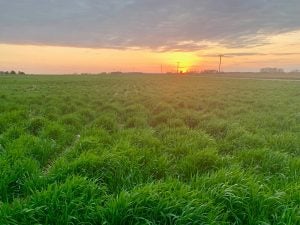
Rye — The G.O.A.T.
First thing is first: “Rye is a grain; annual ryegrass is a grass.” When a person asks me, “How do you plant annual rye?” or “How do you kill annual rye?,” it takes self-control and a lot-a-bit of Jesus to keep my mouth from saying, “What toppings do you like on your McWhopper?” or “Is that leather interior on your F150 Silverado?” “Annual rye” is not a thing. Annual ryegrass is a grass. Rye is a grain. If you want me to focus on the content of your question, make sure you are calling them by their proper names. I say this because they are two totally different species on planting rates, management, and termination methods.
Now that I’ve stood on my soapbox, shook my finger and hollered at the whipper snappers to “Get off my lawn!,” let’s talk about rye.
Rye is easily the largest volume cover crop species in all of North America. With rye’s ability to alleviate compaction, reduce water and wind erosion, sequester nutrients, suppress weeds and nematodes, and provide forage, it could arguably be called the G.O.A.T. of the cover crop species (that’s Greatest Of All Time, for all you internet newbies). You can throw rye in or on the ground, and it will grow with a little bit of moisture and sunlight. If you’ve managed wheat before, you can manage rye. The biggest selling point with rye is if harvest runs late, this is typically the last cover crop species to go in the ground. Back in 2019, many farmers were forced to planting soybeans into standing rye. A term we call “planting green.” I have yet to have anyone tell me they planted green and they will never do it again. The uniformity of their soybeans that pop through the rye, the lack of winter annual weeds, and the C:N ratio that exists through harvest, make it an easy hook for any farmer.
The best part of rye (and its biggest draw to strategic row croppers) is its planting date suggestions. In the Midwest, we have some guys plant their rye in July, and others who plant their rye in November. By March and April, everyone’s rye looks the same and farmers are jumping down the custom app guy’s throats asking when they’re going to spray their rye. Planting rate recommendations range from 30-120 lbs./acre depending on the environment, planting method, and purpose.
In summary: Rye might be the king of the cover crop industry … but Michael Jordan is still the G.O.A.T. Period.
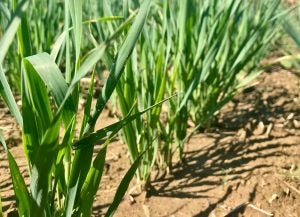
Oats — As Easy As Carpet Farming
Oats are another economical cover crop that can be used for wind and water erosion control, nutrient sequestering, and rapid fall growth for forage and weed suppression. Although oats do not have the root depth that annual ryegrass and rye have, they will still provide that continuous living root system that will help with water-holding capacity and soil structure. Planted early and managed like a true forage crop, you can chop, bale, or graze oats roughly 60 to 90 days after planted in the fall. To achieve some of the key soil health principles, I love mixing oats in with other cover crop species to maximize biodiversity. Oats are a great companion or nurse crop to other legumes. You can plant oats via airplane, broadcasted with fertilizer, or planted in the ground roughly three to 10 weeks prior to the first frost. Depending on your goal you are looking to achieve with your oat cover crop, seeding rate for oats range from 30-120 lbs./acre. Oats typically keel over when they see frost in the forecast, so spring termination is not a concern for the Corn Belt.
In summary: If you somehow manage to screw up planting oats as a cover crop, farming is probably not your thing and I recommend you look for a new hobby/career.
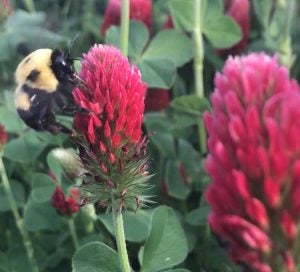
Crimson Clover — Makes My Heart Go Pitter Patter
If it were up to me, I would put radishes and crimson clover in every cover crop mix that went out the door before mid-September. In fact, my personal favorite mix is crimson clover and radish. In every part of my territory, northern Indiana and southern Michigan, that mix always looks amazing above and below ground. Crimson clover is a cool-season legume that reduces erosion. Not only is it fixating its own nitrogen, crimson clover also scavenges for nutrients. It’s great for weed suppression in the fall and in the following spring. Crimson clover works as a fantastic forage and pollinator mix as well.
Times I would stray from using crimson would be if you have the “beat my neighbors to field” complex that farmers tend to suffer from in the spring. This is a make-believe disorder where a farmer feels he/she has to be in the fields before all the neighboring farmers. Why does it matter? You typically want to allow legumes to get as close to blooming as you possibly can stand. Nitrogen production from crimson clover will be greatest when termination occurs at or after bud stage. I would also avoid crimson clover if your goal is to transition into organic acres and crimp that field. Clover’s hollow stems make it difficult to terminate in one pass. Lastly, if you need to spread manure on your fields, avoid legumes like crimson clover if your goal is nitrogen production. If the nitrogen is already available, legumes will not fixate their own nitrogen. If you’re looking to diversify your mix and are looking for ways to spend money, by all means, knock yourself out! I’d be happy to sell you the seed.
For termination, you can set an herbicide jug in a crimson clover field and whisper, “2,4-D,” and the crimson clover will start to die (however, I recommend actually mixing and spraying and reading between my bits of sarcasm). Recommended planting rates on crimson clover range from 4-15 lbs./acre depending on the planting method and purpose.
In summary: If you’re a conventional farmer who will let their crimson clover get closer to bloom before termination, then start figuring out how to integrate crimson clover into your cover crop mixes. Not only will you have a stellar cover crop doing amazing things for your soil in the field, but you’ll also have a bouquet of crimson clover flowers to take to your little lady in the spring when the planter and/or sprayer have held you captive for weeks or months without seeing her. #PitterPatter #BonusPoints #RelationshipGoals
Annual Ryegrass — Your Cover Crop Frien-emy
Annual ryegrass is the most epic frien-emy you have ever met in plant-human friendship. What is a frien-emy you’re asking? It’s a friend who’s also an enemy. You know the kind. When your friends are kind, generous, provide you with your love language needs, and push you to be a better person, they are amazing and you want to be best friends forever. Annual ryegrass will next level your farm. It’s got an incredible, fibrous root system that breaks up hard pans and works hard to scavenge all residual nutrients. Annual ryegrass’s quick establishment in poor soil conditions allows it to suppress weeds and reduces erosion. It provides a yearlong living rooting system. It can also act as forage and can be planted later than most of your other cover crop species. It might not all green-up in the fall, but once it goes through the vernalization period, it historically looks better in the spring.
If you don’t get the backhoe out of the shed and dig a four-foot hole in the spring, you’re cover-cropping all wrong. You will see your soil structure change in the first year of planting a varietal annual ryegrass.
But as I said above, while annual ryegrass can be a good ally and friend, it can also throw you under the bus like a good enemy. Just when you think the management of your relationship is at its best, you get a wet spring. Then BAM! Annual ryegrass takes off and leaves you wondering what the heck you’re supposed to do. It’s more like the friendship on Guardians of the Galaxy when you find out Chris Pratt’s dad [spoiler alert!], who seems to have the best of intensions of making the situation better, is actually the bad guy. Like a really bad guy that you thought you were going to like.
When terminating annual ryegrass, make sure you read and follow all labels’ instructions: right rate, right time, right nozzles, and right products. I would not position annual ryegrass on fields that have historically had delayed spraying or planting in the spring because they are so wet. It does not take long for annual ryegrass and rye to go from 5 inches to 5 feet in perfect conditions. I love pairing annual ryegrass with radish and crimson clover in a field that will be going to corn the following year. Annual ryegrass can be seeded 10-35 lbs. depending on planting method and purpose.
In summary: High risks = high rewards. Thousands of farmers all over the nation are using this species as a cover crop, or I would not be writing about it. Buy your seed through a trusted seed supplier and manage your cover crops like a cash crop, especially when using annual ryegrass.
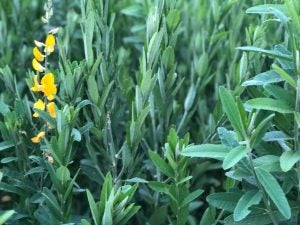
Sunn Hemp — Because I Got High … Amounts of Nitrogen
Depending on the conditions, sunn hemp can produce a significant amount of nitrogen below ground and a mind-blowing amount of biomass above ground in a two-month period. If your cover crop goal is “weed suppression,” plant a heavier rate of sunn hemp and it will provide you great control over your summer annual weeds.
This same concept can be applied if you’re looking for a forage. Sunn hemp is also noted of suppressing root-knot and reniform nematodes. The real magic is when you dig up a sunn hemp plant’s roots. Its nodules on the roots, which visually show you the nitrogen factory of a legume, are insane! Don’t be surprised if they are the size of your fingernails and they are all over the root. Sunn hemp will hold and produce sufficient nitrogen to provide an unbelievable credit for the following cash crop.
Sunn hemp is a true summer annual and should be planted in the summer or when the soil reaches 60 degrees at 5-15 lbs./acre. I don’t recommend aerial seeding sunn hemp on your fields because I want you to inoculate all of your legumes. Aerial application with inoculants that standardly come as a peat compound and is mixed at the planter isn’t exactly ideal for our pilots or the inoculant actually hitting the soil and going to work. Sunn hemp will winterkill at the first frost.
In summary: Some hemp is trendy … but sunn hemp is the coolest!
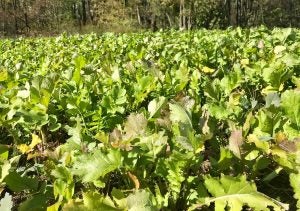
Turnips — Not Just for Eating
Turnips have become high-profile cover crops for their visual image. When turnips are planted in late summer or early fall, they grow a massive amount of dry matter, while helping to control erosion and suppress weeds. There are many turnip varieties on the market. Folks focus on either the tubers and the roots and their ability to break up compaction and cycle nutrients, or they look for a turnip that will regrow quickly for multiple grazing cycles in the fall and winters. If you do intend to graze or feed turnips, it’s highly recommended to introduce livestock to turnips slowly and mix in other dry hay options to prevent livestock health issues. Turnips do really well in dry weather. The lengthier stay-green time period improves sequestration of surplus nutrients left from cash crops. It’s recommended to avoid radish in cropping systems with other brassicas because of the disease bridge (i.e. club root).
Turnips’ seed size is perfect for a broadcast application. Seeding rate for turnips range from 2-8 lbs./acre depending your planting method. Don’t count on turnips always winter killing. A nice dose of glyphosate, Gramoxone, or 2,4-D will smoke your turnips though. If you are interested in trying turnips for the first time, I recommend planting them right around your tree stand. Then in mid-November, take your firearm with you to go scout your turnips. #HappyCoverCroppers are #HappyHunters.
In summary: I love turnips in the field, but not enough to whip out my pocket knife at a field day and start slicing them julienne. It’s not the Depression and I’m not a starving. Just go ahead and put the pork sandwich on my plate with green beans and potato salad and we will call it a win for everybody. Leave the turnip to work its wonders in the field feeding your soil, livestock, and future wall decor.
Rapeseed — Who Are You? The Identity Crisis Cover Crop
All canola is rapeseed, but not all rapeseed is canola. For my 5 o’clock somewhere’ers, it is similar to the fact that all bourbon is whisky, but not all whisky is bourbon. #Cheers #YoureWelcome If you’re looking to plant a brassica late in the fall that overwinters, then look no further than rapeseed! Rapeseed has a really nice taproot that works hard late in the season to capture residual nitrogen and soluble phosphorus left from the previous cash crop. With a deep and fibrous root system, rapeseed is also known for busting up compacted soils. When planted in late summer or early fall, it is the brassica that offers the most biomass production and grazing cycles. I am seeing more rye and rapeseed paired together for a late season cover crop mix. Rapeseed can be planted 1-8 lbs./acre depending on planting method and purpose.
Rapeseed will overwinter in most areas and can be more challenging to control using only glyphosate. If your neighbor’s rapeseed didn’t die after his first pass, it does not mean his rapeseed is glyphosate resistant or tolerant. More than likely, surviving and thriving rapeseed after first pass is the result of operator error. I’m also saying “neighbor” because if you’re reading this and you are someone’s neighbor who didn’t kill rapeseed on the first pass … well … this is awkward. You might share with your “neighbor” that we don’t have to talk about it out loud, but understand in my head that I, your seed dealer, am wondering what step you rushed or skipped when you pulled into that field. Rapeseed is a cool cover crop, but it comes with rules.
In summary: Poor rapeseed has an identity-crisis complex. Most of the time it’s called “canola” and “resistant.” A few years ago, there were concerns that rapeseed was popping up in fields that didn’t have rapeseed in the mix. Rapeseed and turnips look an awful lot alike at the flowering stage … but they are definitely different. If you pull out that handy-dandy shovel, and that rectangle thing in your pocket that has the World Wide Web on it, you can dig the plant out of the ground and troubleshoot that identity crisis all on your own.
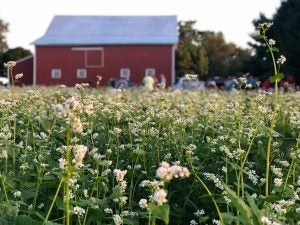
Buckwheat — The Gift that Keeps on Giving, Clark
Buckwheat is such a cool plant. Because buckwheat grows so rapidly, it makes a great weed suppressant and will help control erosion. Below the soil surface, buckwheat is a phosphorus scavenger. It takes up the phosphorus and other micronutrients that would normally be unavailable to cash crops. Then when the buckwheat starts to breakdown, the phosphorus is released back into the soil for the plants to use. The roots also produce acids that release these nutrients as natural fertilizers.
Buckwheat is also known for being a pollinator. Just one acre of buckwheat’s beautiful, shallow white flowers will produce enough nectar to feed an entire hive of honeybees that, typically, produce 150 pounds of honey in a year (Oplinger et al., 1989; Myers and Meinke, 1994). Buckwheat attracts a lot of beneficial insects for cash crops like ladybeetles, wasps, and hoverflies. The seeds are triangular and typically, recommended planting rate is 40-50 lbs./acre.
Buckwheat has been known attract aphids and go to seed. If you are concerned about the buckwheat going to seed and overwintering, I recommend mowing a week after flowering. If buckwheat sees frost in the forecast, it starts to die. It is the fastest cover crop to terminate because of cool temperatures. You can grow buckwheat on your best ground and worst ground. It actually appears to thrive in poor soils — and please note that I said “poor soils,” not “swamp or desert soils,” to clarify for those of you looking for a silver-bullet cover crop.
In summary: Buckwheat is quite literally the “jelly of the month club” cover crop. It’s the plant that keeps on giving for years to come. If you would like to get something “real nice,” with a lot of bonus features, and plant 10 weeks before it gets nipply nippy out, and 15 weeks before your in-laws park their camper on your lawn for the holidays, then buckwheat is your cover crop! #ChristmasVacationPunsForDays
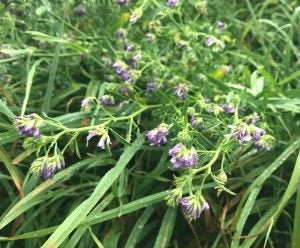
Hairy Vetch — Dirty Cover Crop
“Hey everybody! Come look at my hairy vetch!” is a show-stopping phrase when I’m at field day or a farmers market talking about soil health. But I want everyone to know how incredibly, awesome and stellar hairy vetch is as a cover crop.
Hairy vetch is an annual legume that is loved by cover croppers because of its ability to fixate an incredible amount of nitrogen and has a large volume or biomass that can be used for forage, weed suppression, and erosion control. It’s not recommended to feed hairy vetch to all livestock, though — especially keep it away from horses. Most varieties of hairy vetch have a high hard seed percentage that requires proper spring management, however, there are new varieties coming to market with a softer seed shield. Hairy vetch is slow to establish in the fall, but a great choice for green manure in the spring. Only buy hairy vetch if you’re going to take a shovel out to the field and dig hairy vetch roots in April and May. Recommended planting rate for hairy vetch is 15-40 lbs./acre depending on it’s planting method and purpose. You can terminate using herbicides or rolling/crimping. If you plan to roller crimper your vetch, it’s vital that you wait until 50 percent bloom to make the mechanical termination more effective. The longer you let the hairy vetch grow, the more biomass you will have and the more nitrogen it can be crediting to the next crop.
In summary: When selling, planting, and managing cover crops for improved soil health, make sure you think of all the different ways you can make “dirty” puns.
Peas — Oh How Happy You’ll Be
Peas planted in the spring are notorious for being a great forage option companion with oats, triticale, and/or barely. Not only are these great spring cover crop mixes, but also they are above satisfaction when planted late summer/early fall. When peas are planted with a cereal cover crop, it increases their winter survival. Peas are rapid, low growing legumes that are typically planted into the soil instead of broadcasted on top of the ground. With so much biomass production, peas are great for weed suppression and erosion control.
When the residue breaks down, it releases the nutrients that have been sequestered and produced quickly. Peas planted in the fall need to be planted in the fall at least three to five weeks before the first frost. Seeding rate for peas range from 10-120 lbs./acre.
In summary: The phrase I coined is, “the deeper the pea, the better you’ll be” to ensure that folks don’t spend the money on these legumes and then are not satisfied because their seed to soil contact was poor and the seed did not germinate. I like to rhyme. I do it all the time.
Triticale — Deep-Fried Candy Bar for Livestock
I really enjoy winter forage triticale. Triticale is an intentional hybrid cross between a wheat plant and cereal rye. You have the potential to get the feed quality of wheat, but the biomass of cereal rye. It’s the best of both worlds if you’re a cow/goat/sheep/llama/giraffe on full feed. It’s kind of like a deep-fried candy bar from the county fair … tastes good, you go back for more after you’ve had one, and it maintains those steadfast, invested pounds. County fair and state fair fall into the “holiday weight” category, right?
Triticale’s deep roots and large biomass make it a highly sought-after cover crop for guys looking to achieve soil health improvements and grazing, grass silage, or baling cash crop. Triticale is awesome at scavenging and holding nutrients through the fall and spring. Fantastic weed suppressant because of its fast growth to canopy, shading out the weed. Great for wind and water erosion control. It’s one of the latest fall seeding options after harvest and has great winter hardiness if you get it established right in the fall. I recommend planting 4 to 8 weeks prior to the first freeze and as late as 5 weeks after the freeze.
Depending on purpose and planting conditions, you can plant triticale 30-120 lbs./acre. If planted and managed correctly, triticale can be grazed in the fall and spring. Be mindful of termination in the spring — manage it like you would cereal rye and wheat. You can plant the next cash crop into standing triticale and follow it with glyphosate at boot stage or mow or roller crimper trit in the dough or milk stage of growth.
In summary: Although triticale is historically a little more expensive than rye or wheat, the ROI you gain from the forage value is highly satisfying for you and your livestock. At the last harvest of your time with your triticale crop, you’ll be smiling like you just ate a deep-fried double stuffed Oreo while watching America’s-finest drop their life savings /lottery winnings on carnival rides at the county fair. #LivingTheAmericanDream

Sunflowers — Come On, Vogue
There’s something about a sunflower that can turn a gray day into a happy day. If you want to attract pollinator insects, birds, hippies, and photographers taking pictures of brides and senior pictures, plant sunflowers for a cover crop. Sunflowers are named because of their bright halo ring of petals around the seed head and their noticeable motion of the seed head to follow the sun as the day grows long.
Sunflowers are easy to germinate, quick to grow, and take minimal water to be successful. When looking at a sunflower’s benefit as a cover crop, there’s an emphasis on being a weed suppressant, diversifying root systems, moving water up through the soil, and improving soil structure and soil health, and it is a fantastic pollinator. Not to mention it attracts birds for hunting enthusiasts. It really has few pest or disease problems unless you suffer from a phobia of birds like doves, starlings, blackbirds, and or finches. If you don’t like birds, I’d steer clear of sunflowers. Typically, you do not find a straight sunflower cover crop field. It is often mixed with buckwheat, sunn hemp, crimson clover, peas, oats, and other cover crops following wheat. With a seeding rate of 1-5 lbs./acre, it also makes the sunflower an economical species to add to your summer cover crop mix. Sunflowers will die during the winter and leave a higher carbon residue with the thick stem and seed head of the sunflower. If for some reason you would have sunflowers pop up in the spring, a good ol’ shot of glyphosate will smoke this beautiful broadleaf.
In summary: Vanity is the number one benefit to sunflowers to your surrounding neighbors. You’re the real winner though with all of the soil health improvements and short-term habitat for pollinators and birds. A great scholar once said, “Beauty’s where you find it, not just where you bump and grind it.” — Madonna
Sorghum Sudangrass of Cover Crops = “The Tiger King Series” of Netflix
Hey all you cool cats and kittens. Cover Crop Gal here about to tell you how awesome sorghum sudangrass is as a forage and as a cover crop.
I relate sorghum sudangrass to “The Tiger King Series” on Netflix because its timing is very similar. In spring of 2020, if you weren’t deemed an essential worker, you were at home in quarantine, inside your home during the winter that seemed to never end based on the weather. Then Netflix released a series based off of theme parks (plural) that involved tiger “conservationists” that despised each other. So … we told all our friends about this dumpster fire on Netflix, and they watched it too! By the end of Week 3 of quarantine, if you hadn’t given/heard a full dissertation to/from your family about how Carole Baskin killed her husband, were you even quarantining? And then nobody talked about it again.
I wish I could sell more sorghum sudangrass. I really do. But for my region, there’s about a two-week period where I’m pelted with summer annuals as cover crops questions … a one week lull … and then by the time the farmer is ready to place the order for cover crops, the summer annuals as forages market has swallowed the whole supply, and summer annuals as a cover crop is moved to the next year’s crop plan.
Sorghum sudangrass is a great warm season grass with huge biomass for a multiple cutting or grazing source for livestock. The best part is it actually provides a palatable, high-yielding forage value for guys who want/need quality feed in a short period of time; roughly 45 days to harvest. There is also a brown midrib (BMR) sorghum sudangrass that expresses a lower lignin genetic mutation that makes it more digestible for livestock. This means you get the animal to market faster or gain a milk yield increase because when you digest more, you gain more. I recommend planting conventional sorghum sudangrass 20-60 lbs./acre, and BMR sorghum sudangrass 15-35 lbs./acre depending on purpose and planting conditions. All sorghum sudangrass release chemicals that can reduce the population of some nematodes, such as root-knot nematode. Yields of more than 9 tons/acre of dry matter are possible when you treat it like a cash crop — i.e. applying nitrogen and fungicide if necessary. Sorghum sudangrass has a strong root system and can be planted on a variety of soils. It can withstand a droughty summer.
The watch-out for sorghum sudangrass is prussic acid poisoning. After the first frost, the sorghum sudangrass will be terminated. Hold off grazing or cutting for at least seven days to avoid the high level of nitrates that will accumulate in the lower stalk. If you’re in a droughty period, do not harvest sorghum sudangrass within four days of a good rainfall event. If you’re ensiling sorghum sudangrass, wait at least a month before feeding to give prussic acid enough time to escape. Because of the high nutrient uptake of the sorghum sudangrass and the high C:N ratio, you need to consider adjusting your fertilizer management for the subsequent crop. If sorghum sudangrass is removed from the field as a forage, additional nutrients need to be added to account for the nutrients removed from the field by the cover crop.
In summary: I know it feels like a dark world out there, but I hope you find yourself still counting your blessings. It’s becoming easier and easier to find soil conservationist who want to improve the earth for the next generation. An answered prayer! If you have never prayed before and aren’t sure how to start … try this: “Dear God, Thank you for giving me another day on this Earth to make a difference. And thank you Lord for not letting Joe Exotic actually be a name on our 2020 Presidential Election ballot. Amen”
Pearl Millet — Autocorrects to Pearl “Mullet” Every Time
Who doesn’t love business in the front and party in the back? It’s no secret that in the last year, the mullet has made a powerful comeback from the ’90s. I attended the 2019 National FFA Convention to judge the ag sales demonstrations. Every team that sat down in front of me had a kid with a mullet. No joke — EVERY state selected a team that had a token-mullet-kid to represent them. And every time there was a pause in these kids’ presentations, the chosen one, mullet-kid, would fill the silence with the motion of running his fingers through his mullet in slow motion.
Pearl millet as a cover crop is very similar to the mullet. It’s surprisingly satisfying for everyone/everything involved; soil conservationist, livestock farmers, and livestock. It’s low maintenance because you do not have to worry about water, spring termination, or prussic acid poisoning. If treated like a cash crop, it will consistently out-perform the production of tradition perennial forages. Traditionally, if forage is the goal of pearl millet as a cover crop, you will see a single species planted field of straight pearl millet. You can also see pearl millet mixed with other species in a multiple species mix taking advantage of the summer heat. Common species would be sunn hemp, buckwheat, sunflower, sorghum sudangrass, etc. Pearl millet can be planted in sandy or sandy loam soils at a seeding rate of 5-30 lbs./acre in the heat of summer 3 to 10 weeks before the first frost.
In summary: If you’re planning on feeding an annual forage right after the first frost, “don’t break my heart … my achy breaky heart” by planting sorghum sudangrass and killing your livestock. Plant pearl millet to avoid prussic acid poisoning! #MulletComeBack #BillyRayCyrus
The Big Picture of Cover Crops
The Dust Bowl of the 1930s, the drought of ’88, the floods of ’93, the 1998 hog market crash, the 2018 dairy industry crisis, and the 2019 wet spring that resulted in the highest prevent plant. All of these catastrophes and many other events shaped American agriculture to what it is today. These events in particular were dramatic events that caught farmers questioning why they tried so hard for so little pay. Once they survived these horrific years, they often attempted to put together a plan to avoid anything like this happening to them or their heirs.
In 2020, while the world came to a standstill due to the COVID-19 pandemic, farmers still had to farm to feed the world. We were essential, but we watched the hog, dairy, corn, and soybean markets collapse in a matter of 10 days. 2020 has made us look at Revelations to evaluate how close to the rapture we truly are. But the rapture has been near for over 2,000 years. We need to continue living to improve this world for future generations. How we farm in the future is how we handle ourselves and make our decisions now. Our land is in a very vulnerable state. We can leave the soil crop-free and plan to farm it next spring or we can do something to protect the soil, the nutrients, and the future of American agriculture. I would rather move forward and make mistakes along the way, than look back and regret I did not do something.
Jenna Langley Blue is a regional sales manager for La Crosse Seed in Indiana. You can follow her on Facebook, Twitter, and Instagram.



